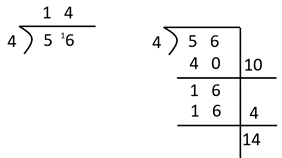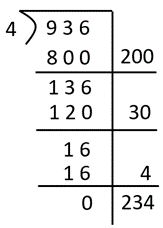The purpose of this activity is to support students applying division to solve quotative division problems that involve dividends beyond a basic range of division facts. Students recognise that place value is a useful structure for partitioning a number being divided (the dividend). This is the basis of written algorithms (step by step procedures).
- Place value materials of interest and relevance to students. This lesson uses ice block sticks in bundles. Any equivalent form of materials, such as BeaNZ or play money will also work.
Pose a quotative division problem that requires students to think beyond basic multiplication facts.
Here are 56 ice block sticks. I will put them into sets of four. How many sets of four can I make?
Set up a material model of the problem and ask students to anticipate the number of equal groups, meaning fours, that can be made.
Students are likely to work with the highest place values first, meaning they will try to make as many lots of ten packets as possible. Below are some scaffolded steps to support them in this strategy.- If you made ten packets of four ice block sticks, how many sticks would that use? (40)
- How many ice block sticks would be left? (56 – 40 = 16)
- You have ten packets of four, and one ten and six ones.
What could you do so you can make packets of four? (Decompose the ten into ten ones to create 16 ones) - How many more packets of four can you make with 16? (4)
How many packets of four can you make altogether? (14).
- The operation can be recorded using working forms or written equations. Below are two useful algorithms: the short form, and the ladder method. The ladder method is useful when division becomes more complex and allows students to make progressive approximations until the full answer (quotient) is found.

- Discuss the connection between the symbols in the algorithms and the manipulation of materials, drawing particular attention to how the decomposition is recorded. The key understanding is that the ‘one’ recorded beside 6 represents one set of ten and is expressed as ten ones.
- Provide further problems, calling on relevant contexts, for students to solve. Look for students to generalise a procedure that involves using place value to partition the dividend. Restrict the dividend to two digits until students gain procedural fluency. Use equipment to model the quantities with the aim of eventually relying on symbols once the place value structures are secure.
Suitable problems are:- 72 people get into teams of three people. How many teams are made?
- 95 people get into teams of five people. How many teams are made?
- 84 people get into teams of seven people. How many teams are made?
- 84 people get into teams of six people. How many teams are made?
- 96 people get into teams of eight people. How many teams are made?
You might allow students to work in groups to encourage peer scaffolding and extension. Other students might benefit from working independently or from further teacher support. Consider also the different means of action and expression (e.g. verbal, written, digital, physical) that your students might use to demonstrate their thinking.
- As students progress, extend the dividend to an increasing number of digits. The equipment model, and algorithm, become more complex with multiple steps. Below is a ladder algorithm used to solve the problem, 936 people travel to the kapa haka festival. They travel with four people in each car. How many cars go to the festival?

Next steps for further learning
- Increase the level of abstraction by gradually withdrawing scaffolding, such as progressing from using materials to algorithms. Increase the difficulty of problems in two ways:
- Progress from two-digit dividends to three-digit dividends.
- Progress from using 2, 3, 4 and 5 as the divisors to using 6, 7, 8, and 9.
- Ask anticipatory questions that promote estimation. Ask questions like:
What size will the quotient (answer) be? Will it be more or less than ….? How do you know?
- Provide quotative division examples where a remainder that must be interpreted in context. For example:
93 students travel to the sports day. There are 8 students in each minibus. How many minibuses are needed?
93 ÷ 8 = 11 remainder 5. This means that 12 minibuses must be taken.